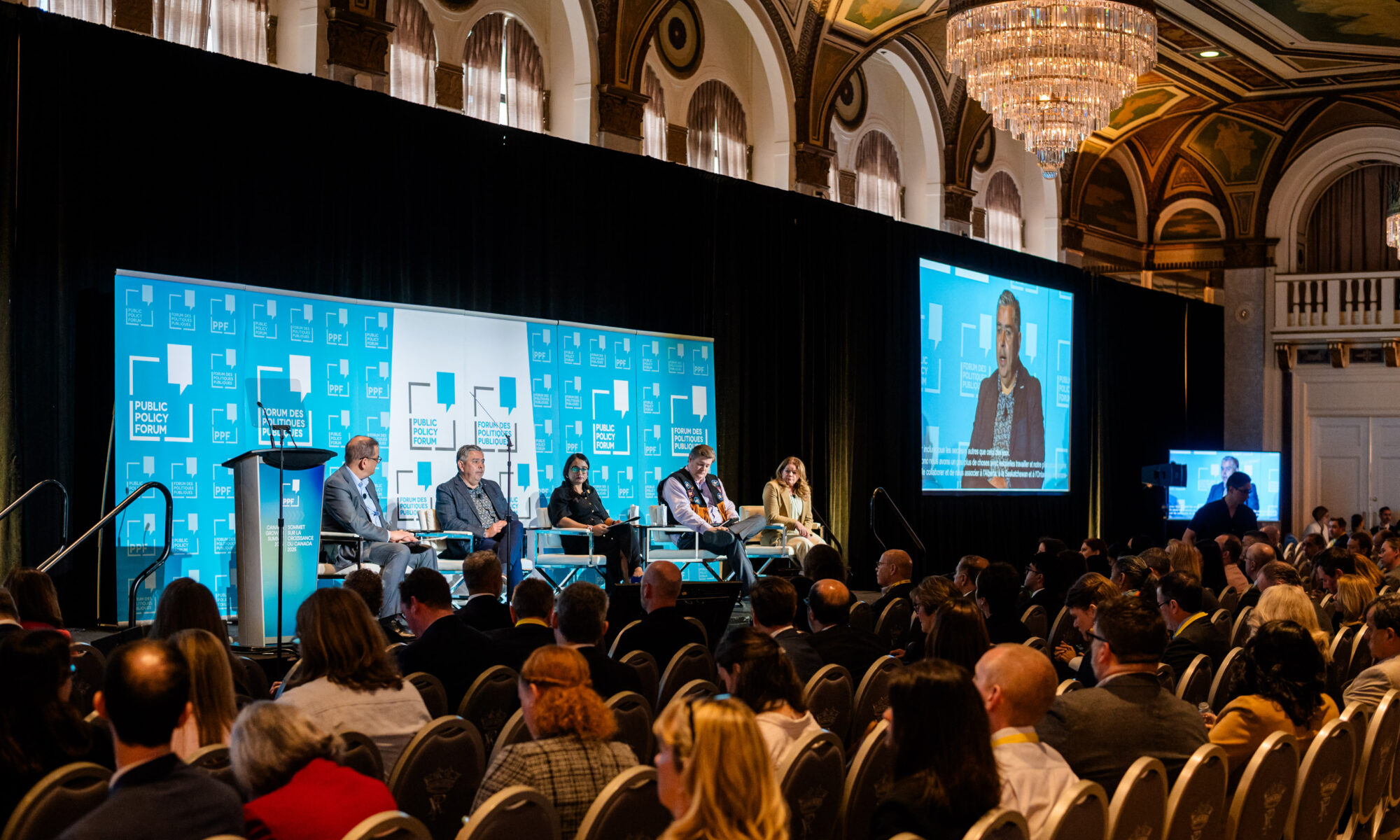
Key takeaways, big ideas and debate: Full coverage of the 2025 Canada Growth Summit
2:38 p.m.
That’s a wrap for #GrowthSummit2025. Thank you for joining us, and stay tuned for replays, transcripts and more here at ppforum.ca. The on-demand replay will be available on cpac.ca.
2:36 p.m.
Jabalpurwala poses the first question to Taylor-Vaisey about the power of narrative and what policymakers should understand.
Everyone in this room is stressed out right now, says Taylor-Vaisey. How can we have conversations without being divided and disagreeing? The goal in his work, he says, is to harness that into a story that gives voice to all these colliding interests. He suggests it’s possible to lean into division in a positive way.
Thibedeau says that “narrative really is the secret sauce.” One of the big things, she says, is that facts don’t sell the story — the facts matter, but it’s telling the stories that grab that reader and listener. If you have that compelling story to tell, that is where you’re going to be heard. She recalls that, when she was on TV reporting on politics on a daily basis, she had to connect it to the viewer — “otherwise they’re just glossing over.”
Abdelmahmoud adds that in a battle between the narrative and facts, “facts get their ass kicked every time.” People are compelled by stories, whether they’re true or not, and people often forget that “narrative gets at the emotionality of a story.”
“What are elections if not plays for your emotions?” he asks.
Thibedeau addresses those in the room, imploring them to ensure “all these great policy ideas” are enacted. Narratives can drive public policy, change public perceptions, and can change what politicians do, she says. It’s vital that these stories get out there and that policy thinkers do not just talk to one another. “You want to influence change, and to influence change you have to tell great stories,” she says. She also notes that the time is ripe to tell Canadian stories. People are interested now. “People are starting to realize that we need to hear these stories and tell these stories,” she says. “We can’t allow someone else to tell our story” or set our narrative. “We need to tell that.”
Jabalpurwala asks how the Canada-U.S. conversation has changed in recent months.
Taylor-Vaisey says Canada is “very hot right now.” His U.S. colleagues are suddenly interested in Canadian politics. They have a reason to want to know about us and to have conversations.
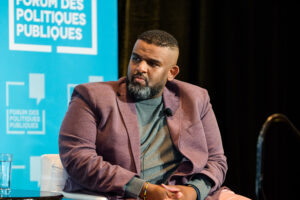
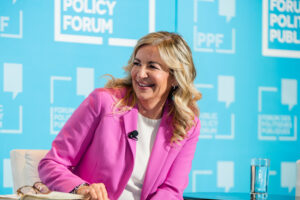
Abdelmahmoud references the idea that Canada’s culture is formed by the two garrisons — weather and the United States.
The conversations that we’re having about the meaning of the Canadian flag have changed drastically, Abdelmahmoud adds, from residential schools to convoys to patriotism.
Jabalpurwala shifts the conversation to the role of the traditional media: Is it still relevant?
Thibedeau says that traditional media “absolutely” still has a role. The mass media gives validity, nuance, and credibility, she says, and still has that gravitas and importance to it. However, she notes that even as a CBC reporter, the possibilities were limited by format and the demands of a newsroom. Now, she says, there are new media, like podcasts, that allow for more storytelling, and that Gen Z in particular are listening to. However she says, there aren’t enough “outdoor cats” – that is, reporters who are out in the field, or traveling with political leaders. There need to be more reporters out there, as they are getting the feel for the world, and getting “more than what we’re getting through this box.”
Abdelmahmoud says despite the rise of the podcast boom, the reality is that Joe Rogan is the most popular podcaster — someone who doesn’t claim to have any journalistic standards. The downstream effect of the podcast boom is a very opinion-driven media environment, Abdelmahmoud says, but the most expensive part of journalism is news-gathering.
Thibedeau also notes that, despite the inability for people to share news links through Facebook and Google, Canadians are still getting much of their news from those platforms — raising the question about the quality of what people are seeing.
Jabalpurwala asks Taylor-Vaisey what’s behind the success of POLITICO’s Ottawa Playbook.

He says it’s the relationship with readers. People say, “I wake up with you every day.” It’s what newspapers used to be for people: building a community and trust.
You are also speaking your audience’s language.
Thibedeau addresses a question from the audience about how to reach young people. We have to reach them where they are, she says. You have to bring them in and get them involved in ways they recognize — shorter sound bites, social videos, and so on — to bring them into these discussions.
Jabalpurwala asks about the impact of AI. Do we still have the power to own our narrative?
We still own the narrative, Thibedeau says. We have to ensure that we don’t forget diversity, because it all becomes formula. If that isn’t fed into the AI, then we will lose our history, she says. Abdelmahmoud says going back to the printing press, people have been scared of new technology, and then rules emerge.
What about a minister of AI, Thibedeau asks? “Do you want that job?” Abdelmahmoud asks.
Taylor-Vaisey offers a last, worrying note about AI: when you use Google search now, the first thing you see in large, bold font is the AI result.
Jabalpurwala asks a big final question: Does Donald Trump understand something about narrative that we need to pay attention to?
Abdelmahmoud says yes. The stories we tell construct our limits of our understanding of the world. The reason we see such a focus on “freedom from” — or negative freedom — in the United States is because we have a plethora of media focussing on it. Donald Trump is a politician that taps into the narrative and emotion that you’re swimming in—he’s a wrestling character, he says.
We think we’re “above” narrative, he says, “but we fall for it every time.”
2:04 p.m.
The art of the message: promoting a growth agenda
Finding solutions to Canada’s pressing challenges is one thing, but how do you put a pro-growth agenda into motion, with broad popular support?
Donald Trump’s trade war has seized the attention of most Canadians and pushed economic growth to the top of the priorities list. People are paying attention like never before. Has there ever been a better time to make headway?
For the final panel discussion of the day, PPF’s President and CEO Inez Jabalpurwala is joined by panelists:
- Hannah Thibedeau, an award-winning journalist and now Executive Communications Officer at Global Public Affairs
- Elamin Abdelmahmoud, host of CBC Radio’s daily show COMMOTION and a writer-at-large for BuzzFeed News
- Nick Taylor-Vaisey, POLITICO’s Ottawa bureau chief and lead author of the Ottawa Playbook
2:02 p.m.
The big topic of conversation: how to improve free trade within Canada. Interprovincial trade barriers have long been a source of frustration and a drag on the economy. But in the face of U.S. trade attacks, there is finally some movement, with Nova Scotia, New Brunswick and Ontario all agreeing to lower barriers to any province that does the same.
House leads off with a question about the successes that the panelists have seen recently. Quinlan highlights the work that Newfoundland and Labrador has done with Quebec on Churchill Falls. “We chose collaboration,” she says, adding that it’s important going forward to focus on tangible delivery and real outcomes.
Sarah Thiele says internal trade is trendy right now with the “elephant next door.” It’s important to remember that it’s a tool in a toolbox, not the whole solution.
“We can’t replace U.S. markets with Canadian ones,” she says. Where we focus on Canadian markets, we need to be precise and keep in mind social, environmental and regulatory factors. Nevertheless, she says, the “political will” from premiers and the like is exciting.
“That positive shift is so vitally important,” she says, and also highlights the success of the New West Partnership Trade Agreement (NWPTA) agreement, which has expanded credentials and more across B.C., Alberta, Saskatchewan and Manitoba. “We’ve worked very well across the western provinces,” Thiele says.
The Buy Canadian movement in and of itself also breaks down internal barriers, she says.
DiEmanuele says that the conditions for success have changed. There are four critical wins there, she says. First, leadership at all levels, from political to private sector to think tanks. Second, the work that’s been done at the conference of first ministers table. There is a relationship now. Third, the notion of control. We have control over interprovincial trade and we can make a difference there, she says. And the last thing is not looking for a huge master agreement that is packed with exceptions. The shift now is happening piece by piece and with real commitment.
How do you create the conditions for success and set priorities?
Quinlan notes how long conversations about interprovincial barriers have been happening, adding that “we can seize on those long-standing strategic conversations,” and focus on tangible benefits with the most impact that we can deal with in the short-term. Workers, she says, are not working on policy timelines – they’re working in real life, and we want workers to move where the work is when they’re needed.
Thiele agrees that a pan-Canadian approach won’t necessarily work. “Where we’ve seen success is locally and regionally,” where changes make sense to people, she says
“What we call red tape didn’t come out of nowhere,” she says, which is especially true of labour mobility in health care, where regulation emerged out of a need to keep and attract talent in rural communities. So, we need to be particular about the trade barriers we are focussing on.”
Manitoba has allowed free trade of alcohol for years, she adds, and it hasn’t hampered their economy. But it’s also important to consider the differentials of provincial resources — Manitoba’s whole budget is what Ontario spends on highways, she says.
DiEmanuele says government is highly structured vertically. How do we morph and change the way we structure bureaucracy, she asks. And then change will require “good old fashioned” rigor and discipline.
A higher risk tolerance is also driving change. Ontario introduced two historic bills around trade and licensing. They are “so different” from what we were doing recently. How do we learn from this period in ways we didn’t from COVID, when we reverted to old ways?
“The Premier said to me one day, ‘why are the pages of risks always so much longer than the benefits’? It was a really important moment,” she says. Don’t let what can stop us, stop us from thinking about what’s possible.
House notes that the panelists have discussed mutuality and reciprocity and how it’s advancing us slowly, but “it isn’t going to give us the big bang” for Canada. What will it take to get beyond reciprocity and get the other provinces to simply open up?
We’re not at a loss for what we can do, says DiEmanuele. The premiers are working their way through issues. It’s one foot in front of the other.
Thiele says we don’t achieve much through policy without political will, and the public has a way of having more conversations and a growing understanding of internal trade — including a person receiving the same level of care anywhere at any hospital in Canada.
An “all-in” project between the provinces will prove what’s possible and loosen regulation too, she says. “One big example of a win will crack this thing open.”
1:39 p.m.
Clerks panel: Canada’s public service leaders on how to boost trade
One of the most unique and closely watched panels at the Growth Summit is the gathering of some of the country’s top public servants. This year, the panelists are:
- Krista Quinlan, Clerk of the Executive Council of Newfoundland & Labrador
- Sarah Thiele, Clerk of the Executive Council of Manitoba
- Michelle DiEmanuele, Secretary of the Cabinet of Ontario
They are joined by moderator Brett House, a Senior Fellow at PPF and a Professor of Professional Practice at Columbia University.
1:35 p.m.
Ford is now joined on stage by CPAC’s Michael Serapio for a short Q&A session.
Serapio begins by asking Ford about interprovincial trade. Where are we on that?
Everyone wants it but there’s a lot of protectionism, says Ford. A doctor or nurse who gets a licence in Nova Scotia or New Brunswick should be able to practice anywhere, he argues. We can’t have exceptions. We have to open it right up.
Ford says Ontario is one of the largest markets in the country. Provinces “should be doing cartwheels” at the opportunity to access that market, he says. Serapio asks whether Ford is optimistic that things will be “open” by July 1, as Liberal leader Mark Carney has promised. Ford says that he’s “optimistic” that they will meet that target before July 1.
Serapio asks what the Team Canada approach looks like.
“When we step out and speak to the world, we have to be united. It’s absolutely critical,” Ford says. “My message is let’s build an AM-Can fortress.”
Canada also has to hit the two percent NATO target, he says. That’s part of maintaining an important friendship with the United States.
Ford says getting the message out is important. “I feel like jumping through the television when I hear Trump say ‘we don’t need Canada,’” he says. I guess the farmers don’t need the potash or the uranium, or the high-grade nickel that they use for their aerospace and manufacturing, Ford says. “And obviously, the electricity,” he adds, referring to the hydro power that’s shipped to states like New York and Minnesota.
The other night we heard Trump once again talk about Canada as a state, says Serapio. Where are we with the U.S. president?
Ford says, “sometimes the cheese slips off the cracker with this guy.” He wonders if Trump’s team even knows what he’s going to do. “He’s created uncertainty all over the world.”
Ford turns to investment now, noting that $70 billion has come through Ontario in recent years. A million more people are working in Ontario today than seven years ago, he says.
People don’t realize that Ontario is a leader in tech in the world, Ford says, reminding the room that generative AI was invented in this province. Ontario employs more than 400,000 people in tech, he says, and suggests that the brain drain from Ontario to Silicon Valley.
Serapio asks Ford how you increase growth in Canada aside from cutting taxes and regulation.
“My new word, two words, faster and speed,” he says. Ford says the Ontario Public Sector is frustrated about their processes. He pushes the Lean Six Sigma theory, saying that it’s been implemented in the OPS.
“It’s not about cutting, it’s about driving process,” Ford says about how the OPS operates. Just imagine, he says, if we can get mining going, and we work with the federal government and we can get permits in less than 24 months, we’d be the richest sub-national jurisdiction in the entire world. We’d be the wealthiest nation in the world. Our critical minerals … [are] like Alberta’s oil. There’s hundreds of billions of dollars sitting up in the Ring of Fire that the entire world needs and wants. Yes, we can ship it down to the U.S., but we can ship it to the entire world.
Infrastructure spending will continue, which will also drive skills training, he says.
He also highlights his distaste for political stripes, noting how closely he now works with the federal Liberals and Wab Kinew’s NDP government in Manitoba.
“I’m proud to be the leader of the PROGRESSIVE Conservative party.”
Stay tuned for a full transcript of his remarks.
1:28 p.m.
Ford says this is a serious moment for the province and the country. For decades we’ve relied on a relationship with the U.S., he says, one of the world’s most successful relationships.
The last several months have shown that the trust is gone, he says.
We will continue making the case at all levels of government in the U.S. that we’re stronger when we work together, but we can no longer have our economic success rely on such an unreliable partner.
Differentiate the American people and President Trump, Ford says.
Trump is openly taking aim at Ontario’s economy, putting all of us at risk, including the American people, he says. Ford says he’s reached out to Americans, who all agree — behind closed doors — that Trump’s attacks are not beneficial to Americans.
In response, we need to do everything in our power as Ontarians and Canadians to become as resilient and self-reliant as possible. We’ve put all our eggs in one basket over the years, and we’re changing that now. We need to tear down red tape, unlock our resources and unleash our economy. We need to make Ontario the best place to do business.
We need to stand on our own two feet so we can protect Ontario. First, we’re tearing down barriers that stop free trade, he says. It’s amazing that we can trade with the U.S. and 51 other tariff-free countries but we can’t ship Ontario wine out to B.C. Interprovincial trade would increase our GDP from seven to eight percent, he says, and free trade in Canada is worth more than the tariffs we’re facing from the U.S.
Ford says Ontario has already signed agreements with Nova Scotia and New Brunswick to promote interprovincial trade.
The province is also unlocking resources with greater resource development, he says.
Ontario is blessed to have unlocked minerals that the world needs. People don’t realize this, but we’re getting the message out. But it takes up to 15 years to get a permit to open a mine, while the rest of the world is giving permits in a year or two years.
Permitting delays are driving investment away, he says.
A mining company, he says, called him and said they’d been at the permit application process for seven years and they were down to the last 16 questions and were going to take their investment to Australia or Quebec. Permitting delays are driving investment away, he says.
We have more critical minerals than anywhere in the world that people want, he says, but red tape is standing in the way.
Ford says that environmental assessments are being duplicated, and that both major party leaders agree that there should be a ‘one window’ solution. We’re going to get critical minerals out, we’re going to refine them here, and we’re going to produce it here with Ontario workers, he says.
We have a phenomenal relationship with First Nations communities. Communities near the Ring of Fire, Ford says, will benefit from the development, like better health care and services.
Ford shifts to talking about housing and infrastructure, including nuclear energy and SMEs. Clean energy remains a priority, he says. He says he reminds U.S. officials that American firms are involved in these developments.
“We have some of the smartest nuclear minds in the world, right here in Ontario,” Ford says. We have requests from Europe about small modular reactors, he adds.
Our government is championing new nation-building pipelines, seaports, highways and railways to connect all provinces and help the flow of goods. Every public official needs to take responsibility for the fact that we don’t have pipelines going out west and east — or going north out to Hudson’s Bay. “We wouldn’t have to be reliant on the U.S. and selling them discounted oil.”
This plan is to protect Ontario and to protect Canada — it’s about more than the immediate tariffs we’re seeing from Trump. “He wants to destroy our economy. He wants to destroy our auto sector, our manufacturing sector. He wants to take over Canada, but I’m telling you Canada is not for sale, we will never, ever be the 51st state. We have two options, either roll over or we stand up and we fight like we’ve never fought before. I like the latter. Because I can tell you, he doesn’t respect weakness. We need to show him strength.”
Ford says you have two options when you face a bully — let him run you over or fight like never before. He chooses the latter.
We’re going to invest in infrastructure, workers and communities, cut red tape, and protect companies, he says about Ontario’s plan going forward.
12:46 p.m.
Doug Ford on Fortress North America and getting investment flowing
Ontario Premier Doug Ford joins us next. Premier Ford has emerged as a key voice in the Team Canada response to Donald Trump’s trade war attacks. He’s been a frequent guest on U.S. cable news shows and a strong proponent of a national economic agenda.
12:41 p.m.
This year’s guest speaker is one of the most respected voices in journalism today. Andrew Coyne is a columnist at The Globe and Mail and a go-to source for many Canadians eager to understand the currents moving the Canadian economy.
Coyne begins with the productivity puzzle. How can it be that if Canada has done everything right, why are we in this fix, with lagging growth?
The short answer: We did the right things with orthodox economics. But we also did other less orthodox things. Nobody knows where we are going to win. We have a history of picking winners, and nobody actually knows.
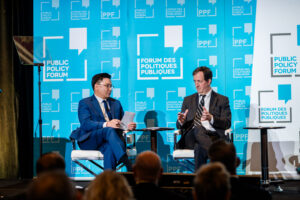
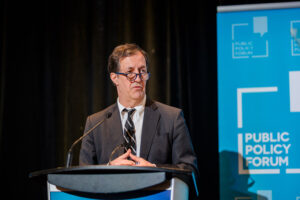
We had a suit of things around modern supply-side economics. There is a trend toward more and more spending, but if you’re focused on quantity and not quality, you risk falling into the same traps.
Coyne runs through a long list of programs. We are not short of innovation programs, and the Liberal government under Trudeau added to them, he says — there are 106 skills programs across 30 departments. The main problem we’re facing is the shortage of investment. The reason why our workers are less productive than in other countries is that they are working with less capital investment.
We need a shift in approach, he says.
We have a lot of work to do to get our corporate tax rates down and increase foreign investment. You can have all the investment, but you can still have a problem, so we need incentives to use that capital efficiently, including more accurate pricing.
Coyne says we have to stop thinking about innovation as a scientific process and think about it as an economic process. If we want businesses to do the small things that create productivity, it’s not about the big gee-whiz inventions, it’s the small things that happen every day. “You want every manager lying awake at night thinking ‘what can I do on the shop floor tomorrow to make things better – because if I don’t the competition will eat my lunch’?”
But what do we see, he asks? Oligopolies in the airline, telecommunications and agriculture industries. We’ve protected them against foreign investment and competition. To solve the productivity paradox is not that complicated, Coyne says. Get serious about opening ourselves to foreign investment, break down the oligopolies and cartels and get serious about competition.
12:11 p.m.
Beaulieu kicks things off with a question for all the panelists: The room is full of leaders, what’s the one lesson you’ve taken from engaging with AI that you’d like to share with them?
Janssen says that she sees a few common mistakes happening in organizations when it comes to implementing AI. One of the biggest mistakes, she says, is that AI lives in IT. “It’s not an IT project,” Janssen says IT is a companion to an AI project. Many organizations say to their IT department — the ones who’ve made careers on keeping us safe and locked down and secure — ‘tell us how to use AI and when to use it.’ That, she says, is the death knell to AI. Janssen also reminds everyone to “stop building cool AI.” By that she means: “Stop asking the question: ‘What should I build with AI?’ Ask: ‘What are my biggest business problems and is AI the right tool to solve it?’” Janssen also emphasized the importance of change management. Seventy percent of an organization’s first AI project, she says, will be change management. “Be ready for the concern, be ready for the fear.”
Corbo says it has never been easier to use AI in software activities. The number of software engineers that were required to take on projects a few years ago was outside of the resource capabilities of most organizations, but not anymore. “Every organization needs to be thinking about what they can build themselves,” he says.
AI has “never been more accessible to organizations,” he says, but there has to be a willingness to adapt and “refactor workflows and not have people pushing people [in roles] that could be completely automated.”
Bak says: Get prepared for very rapid change. Organizations are going to have to deal with change, so get ready for it, he says, likening it to a jet engine shoved up the tailpipe and it’s about to take off. You may not have a choice in this.
People start to see the value of transformation and then begin to innovate. His organization went from resistant to one that demands innovation.
And this is becoming so much easier to do oneself, he says. It’s highly agile and fast.
Deaville says there are the early adopters that lead to little pockets of activity. Change management involves getting the early adopters to share their knowledge. The value from this is at the working level, the folks that are really terrified are the ones doing the day-to-day work.
Beaulieu notes that the list of things to focus on with AI from a policy perspective is long. But what, he asks, is a key thing that officials can do at a provincial and federal level to actually help Canada and organizations close the gap that’s appearing around nimbleness in AI adoption?
Bak says there needs to be more of a policy push. “We as the doers have to make it happen, and government isn’t helping that along.”
Corbo has spent a lot of time in the U.K., where his last business was headquartered, and says that Canada can fall into the same trap as Europe does “to think about innovation at the level of regulation.”
He says it’s “lamentable” that Canada led in AI research but doesn’t have more places where it’s “winning,” and “creating category-defining companies.” That in part because there isn’t a cohesive vision for where we can excel, he says. Some countries, like the Netherlands, have done this well. What are the regulatory sandboxes we can make to ease adoption, he asks.
Customers matter, he adds, because in addition to the companies there needs to be a willingness to purchase and engage. There isn’t necessarily that culture in Canada, he says.
Janssen agrees with Corbo. “We suck at adoption,” she says. The sales cycle is a great example — it’s 18 months in Canada, it’s four months in the U.S. AI is out of the bag, our organizations have to start adopting it, we have to set up our structures to encourage investment. “Where is Canada going to win? We have to decide, and we need to lean in.”
Beaulieu poses a rapid-fire question to end the panel: What’s the most overhyped thing out there?
Janssen says: Stop taking the latest and greatest. Use the method that works best for the problem.
Bak jokes its photo manipulation software that makes people look older or younger.
11:44 a.m.
Accelerating innovation with AI
There is no question that AI is a revolutionary tech. It’s here and it can’t be ignored. There will be some big winners and losers as it sweeps through industries. How are Canadian companies using AI to drive innovation and growth?
The AI panel includes:
- Jacomo Corbo, CEO and co-founder, PhysicsX
- Todd Deaville, VP AI Innovation at Magna International
- Peter Bak, CIO, Humber River Hospital
- Nicole Janssen, Founder & Co-Founder & Co-CEO at AltaML
André Beaulieu, PPF Board Chair, is the moderator.
11:43 a.m.
Raitt begins by saying Canada will need to address three things. First and foremost, it will need to address housing affordability, she says. Next is wage competitiveness — students know what they can make in other countries and they do the calculations. Third, career opportunities.
Thomson says top talent are often looking for places where they can expand and focus on their expertise, and Canada sometimes likes to “spread out [like] peanut butter.” But the good news is they move to Canada because they want collaboration, they want Canadian culture — things like school systems, health care and more — and crucially, the move for a “sense of ambition” that Thomson says “we have to work hard not to lose.”
Chatoor says that Canada has one of the best education systems in the world and being able to leverage our systems will go a long way to making Canada more attractive in the long run. But, he says, the labour market is in flux. Youth underemployment is 7 percent and youth unemployment is double that. “There are underlying issues in the labour market, beyond the tariffs, that have been going on for years” in sectors like health care or construction, which in that case have directly impacted housing costs. Canada needs to think about attracting talent strategically, especially for future sectors like AI. We need to make sure our systems are responsive to the needs.
Thomson says universities have the capability to create new industries, and U of T has been looking at ways to attract talent to do that. In Ontario, there are 55,000 people in AI in “jobs that didn’t exist 10 years ago,” Thomson says, that have come out of the past decade’s research. Attracting talent gives you “the opportunity to look just over the horizon,” he says.
Lucas asks about increasing participation of underrepresented groups. Raitt says that on this topic she listens to the experts, like JP Gladu, but notes that you have to make places available. There are impressive people out there and Canada doesn’t always recognize that we have to aggressively pursue homegrown talent. You also have to support Indigenous-run companies that have long term ambitions and plans, she says.
Lucas asks for perspectives on what we need to work in the world of AI.
Chatoor replies, noting that when it comes to developing talent in Canada for the future, there is a need for training among the general population on how to use AI. Workers need to be empowered, not intimidated, to use these tools to perform tasks at work, he says. Other countries have been better at this than us. We have great development expertise in AI, but we’re not showing people how to use AI as a skill. This is something that we expect will be needed. Having a national approach on how we want to upskill the population in regard to that is something we should think about doing — and we can look to others, like Australia, for ways to do that.
Attracting talent is one thing, but what about retention, Lucas asks?
Thomson says another area where we can improve is our credential system for both recognizing existing skills and helping people take the next steps. For example, making ways for people to transition between training and working so people don’t have to entirely leave the workforce to go back to university.
When it comes to retention, Thomson says there’s been an “avalanche of interest from Americans coming up to Canada,” but the crucial part is figuring out who’s around to stay. “Are these just academic refugees looking to hide out for the next four years from Trump?”
Raitt jumps in to note Canada has a good health-care system, safe cities, a pretty good work life balance, robust worker protections. It gives Canada a solid foundation in comparison to the U.S.
But what about labour mobility?
Everyone agrees it should happen, says Chatoor, but the question is how it can work to avoid regional vulnerabilities like localized brain-drains. While there are some core sectors that every region needs, such as health care and construction, there are differentiations between economies, too. There are also instances, like Saskatchewan, Chatoor says, where health-care workers may need to go outside the province for training — and the province has to simply hope that they come back. You want to give Canadians freedom of mobility, but part of the challenge is to give everyone a voice. It is happening, and the window of opportunity is open, but we need to take it.
Thomson says funding goes where the specialists are, and that’s going to concentrate talent in metropolitan centres like Toronto or Calgary. We need to prepare for the pressure that’s going to put on those cities, he says.
Lucas asks what advice each panelist would give to the government to attract talent.
Raitt jokes, “Build a pipeline.” Government can reduce red tape, she says. She also highlights, to applause, the burden on caregivers as a huge problem that demands ongoing attention. Chatoor reinforces that the window of opportunity that exists to discuss interprovincial mobility and trade won’t be open forever. “Take advantage of it,” he says, while everyone is still keen to talk about it and solve the issue.
Thomson says we are going to need to adjust as we move to a multipolar global power balance and focus on young people and the quality of life they want to have in Canada.
11:11 a.m.
Is Canada winning or losing the talent war
Donald Trump’s chaotic second term has sent shockwaves through the U.S. economy. Anecdotal evidence suggests it is already driving away talent. Is this an opportunity for Canada to lure some of the best and brightest? Is Canada still a great place to work or are we losing talent to greener pastures?
This next panel includes:
- The Hon. Lisa Raitt, Vice-Chair of CIBC Global Investment Banking
- Andrew Thomson, GR Chief U of T
- Ken Chatoor, Director of Research and Strategic Foresight at LMIC
Stephen Lucas, CEO of Mitacs, a not-for-profit organization supporting research and innovation, is moderating. There is a “talent war,” he says. How can Canada play to win?
11:00 a.m.
Moderator Luiza Savage, the executive editor for growth at POLITICO notes that sometimes it takes a crisis to sharpen focus. Is this a crisis or opportunity for Canada? She takes a poll of the room. The opportunity side has a slight edge.
She begins the panel conversation by noting that stagnant business investment in Canada is a longstanding problem. Growth has come from people working longer hours, not from productivity gains.
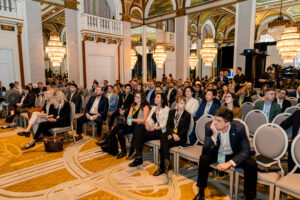
She asks: If you had to cut through the usual talking points — what’s really been holding us back?
Michele Harradence has worked in energy for 25 years and lives now in Texas. “There is an ecosystem around investing in innovation in the U.S.,” she says. “We don’t have that in Canada.”
“We’ve lost sight of the fact that we are a natural resource economy, and there’s a way to productively and sustainably take advantage of that,” she adds.
One way to build that ecosystem is with faster and more certain decision-making. “Our regulatory system doesn’t lead us to ‘yes’ or ‘no’,” Harradence says, “and no is fine as an investor if I get it in a reasonable and timely manner.”
Mendelsohn is asked the same question. “I do not know,” he says bluntly. To everyone in this room, he says, it’s our fault. What we’ve said the problem is, is not the problem: Capital taxes are too high. Deficits are too high. There are too many regulations. He says we’ve tackled these things and seen that there is no correlation.
“I say with all humility that the economy is changing dramatically,” he said. “There is enormous disruption. I don’t know what the world looks like six months from now. None of us do. But what I will say is that, as was discussed earlier, we have an enormous capacity of resources. … It is really a choice for people in this country, Canadians, to invest in this country.”
Canada has huge capacity in resources. It’s a choice for Canadians to invest here. And private sector firms could be investing more, he argues. “There are no public policy obstacles” to that happening.
Asked if he agrees with that, Tertzakian says no.
He has been at boardroom tables for the last 30 years, and he says if the people in the boardroom cannot understand the deal or the investment, they will say pass and move on to the next one that might not be in Canada. He’s not against guardrails but says he’s against ones that are “disjointed … and no one can understand” that have been implemented starting around 2017.
Tertzakian says we’ve lost the U.S. market because investors there don’t understand the way to analyze Canadian deals’ potential risk and return.
The next question from Savage: You’re economic czar for a day — no consultations, no white papers, no endless roundtables. You have two minutes to give marching orders to the next government and business leaders. What’s your boldest, most impactful move to reignite business investment?
Harradence says we need to decide what we want to be when we grow up — not if we’re going to take something on, but how.
“Our job is to take risks, but we do that eyes-wide-open,” she says, emphasizing the importance of a regulatory environment that is simple and clear.
Mendelsohn’s response is that not all investment is equal. We need to find ways to liberate capital and get it to people and places where it will be most effective, he says. That could include equity ownership in projects or getting capital to people who have faced barriers.
It also means de-risking entrepreneurship, such as reducing reliance on personal guarantees that entrepreneurs are forced to sign.
And this is needed on a large scale, too. We’re starting to see the federal government move toward loan guarantees for Indigenous groups in resources development, for instance, he says.
If Tertzakian were prime minister for a day, he says he’d take stock of all our policy regulations, which he thinks aren’t working.
“I am against dysfunction, and I’m against complexity, and so are investors,” he says, adding that Canada needs a leader to stand up and welcome business investment. “If you listen to the English language debate, not one candidate said ‘we are open for business.’”
He says leaders shouldn’t use euphemisms to describe our natural resources — “why are we scared to say mining?” He agrees with the sentiment that we are embarrassed to be a natural resource economy. Mendelsohn disagrees.
Mendelsohn argues that one of the big goals has to be to rebuild state capacity. Canada needs to have an integrated industrial strategy around mining and processing resources that draws in private capital.
Whichever government gets elected, Harradence says, they need to listen to people. Enbridge moves energy to houses in Ontario, and those people have been clear, she says — they are concerned with affordability.
“Sustainability is not just about the environment, it’s about the economy and people’s lives,” Harradence says, adding that we’re finally starting to have pragmatic conversations about that “if we lose sight of that after next week, shame on us.”
10:27 a.m.
Lagging business investment is a well-known problem. So how can Canada accelerate investment to drive economic growth?
On the panel for this session, moderated by Luiza Ch. Savage, Executive Editor, Growth at POLITICO:
- Michele Harradence, EVP & President, Enbridge Gas
- Matthew Mendelsohn, CEO of Social Capital Partners
- Peter Tertzakian, Founder of the ARC Energy Research Institute
10:22 a.m.
You’ve all been on the front lines of the Canada-U.S. relationship, says Tombe. Help us understand how this moment compares to past moments of tension and uncertainty, he asks.
Blais remembers her time as consul general of Canada in the southeastern U.S. where she saw the rise of Trump. She visited automotive plants that wouldn’t be there if not for NAFTA, she says, but workers at those plants said they were voting for the person that would tear up the deal. What saved a free trade deal from being completely torn up, Blais says, were relationships, including with state governors.
“Those relationships matter,” she says, adding that you have to build that trust proactively. “You have to navigate dissent and difference of opinions very judiciously, and we have to get back to building those relationships or we’re not going to get out of the bind that we’re in.”
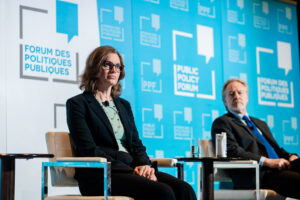
Verheul says the atmosphere reminds him of Trump’s first term, where he announced he would rip up NAFTA. “We got from there to the negotiating table where the U.S. put forward some extreme, unacceptable terms, and we got through those and ended up with a good agreement. Now, they are more far-reaching but the same patterns from the first term are being repeated. Very extreme proposals, but we’re already seeing signs of them backing down. Trump is sending signals that he’ll back down on tariffs on China, or on cars. The economic markets have acted as a guardrail against anything too dramatic.”
For this kind of environment, Verheul says we’re still in the phase of full-scale, very poorly thought-out proposals and the lessons of how you can’t do that are coming to the fore. “But I think in all of this, and heading toward a more reasonable period, it will be a difficult negotiation on key sectors. The U.S. market will be back. I don’t expect business to shift all their efforts to Asia or Europe, because they’ll have to shift back.”
De Silva offers a note of optimism. If you look back over the course of 20 or 30 years, we’ve been here before, she says. There was the chaos around the 2008 economic crisis, for instance. “We’ve weathered storms with the United States.”
Hosting the G7 will be a unique opportunity for Canada to develop other relationships. But Canada and the U.S. are “neighbours for life” and will need to find a way to resolve differences. “We have to keep talking, even when it’s hard.”
The biggest opportunities that we have lie in Canada, Blais says. “Any solution to this crisis that we have should be done at home.”
Those measures include stabilizing our productivity crisis and investing in Canada. We need to focus on what we have already, Blais says, including our rich natural resources.
“It is not a curse to have a great oil and gas industry. It is a blessing,” she says, adding that we can tap into this resource by working with Indigenous communities and addressing our carbon emissions.
On the international front, Blais says her experience at the UN has led her to believe Canada has to adjust its language to lecture less and solve more. “We are a medium power,” she says, “So we’re respected, but we’re not going to solve all the world’s problems.”
Verheul says there is lots of talk about diversifying markets “but I don’t think there are any quick fixes on that front.”
The even bigger timing problems are on the U.S. side. It takes far too long to repatriate manufacturing. And it will be “horrendously” expensive. The U.S. markets and business communities understand that.
The CUSMA complaint exclusion from tariffs is a positive sign that a deal can be made but the crucial negotiations will be around key sectors and goods like steel and aluminum. Ultimately, this will be a negotiation about trade security, says Verheul. The U.S. will figure out that isolation is not the best route to go down. The U.S. needs Canada.
Tombe asks about U.S. trade and diplomacy through the lens of politics. What do conversations look like from inside the rooms where they happen — how different is it from what we see publicly?
Blais stresses the importance of listening. “What we saw with Zelensky was an outlier,” Blais says, adding that she still frequently visits DC and “all exchanges are extremely warm and heartfelt.” But sometimes you can’t trust politeness in diplomacy.
“You have to read body language and understand that things are not always said to your face,” she says. “You will have polite conversations that went terribly.”
Blais says it’s also important to understand that Canada is the smaller player and has to adapt: “We have to bring them to the water well.”
Verheul says that once you get to the table it’s a very different atmosphere where you don’t need to win political points. There is pressure to reach a deal, which leads to more and more compromise to meet the needs of both sides. That, he says, is where we need to get and it tends to work well for Canada.
Understanding who holds the levers of power is crucial, adds De Silva. As is having conversations with people before you get into the room and with people outside of Washington. Premiers in Canada are key to those relations. “As long as we can be reunited and work to common goals” Canada will do well, she says.
Blais says leaders “should stay in their lane” — premiers working with governors, for example. If not, she says, we risk sending mixed messages, and any discussions between leaders at different jurisdictional levels should be carefully planned “to make sure we don’t end up with a cacophony in D.C.
If all provinces and industry are not on the same page, it’s a weakness that can be exploited by the other side, concludes Verheul. During the CUSMA negotiations it was a big strength for Canada.
9:55 a.m.
Navigating disruption: What the next 100 days could look like
Whoever wins the upcoming federal election will immediately face a barrage of pressing policy issues, not the least of which will be managing the relationship with a hostile America. The implications for the Canadian economy will be profound.
Economist and PPF Fellow Trevor Tombe is moderating a panel including:
- Steve Verheul, President of Steve Verheul Consulting and Canada’s former chief trade negotiator
- Louise Blais, associate at Pendleton Group and a former ambassador to the UN
- Gitane De Silva, Founder and Principal, GDStrategic
9:54 a.m.
Moderator Marta Morgan, a senior advisor with McMillan Vantage and a former Foreign Affairs deputy minister, begins: “We are in a very turbulent time with geopolitical uncertainty that’s prompted a national discussion on what we need to do in Canada to build our own resilience.”
To start, Morgan asks McAdoo to share how Canada is seen by our trading partners and our potential trading partners, in his experience? “Canada is very well perceived,” he said. In a large survey of free trade agreements done by his team, Canada was classified as a “free trade stalwart,” he said.
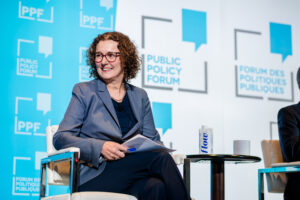
“It’s in a good club of countries.” The problem is the U.S. is still north of 60 percent of Canadian trade. Diversification is going to be a huge challenge, he said.
Leach adds that Canada has a very highly-skilled labour force and more that we cannot underplay, but this moment is about turning those strong inputs into strong output. We have structural deficits, she adds, which are a reason that Canada will need to work harder.
McNaughton says: The other thing is historically there are a number of sectors in the economy where we used to be out finding new markets, like mining. When we talk about diversification and look at some of the countries with products that could be exported, a lot of them are not of the size to take on that effort so we need to find a way for government to be supporting these companies that could diversify, but it’s really challenging for them.
These are perpetual challenges for Canada, but the current circumstances are motivating, Morgan says. She asks: Have you seen any evidence that companies are starting to think more seriously about this and taking action?
If you’re in the auto business right now, McNaughton says you’re thinking about how do I survive for the period that this continues and there are companies — and I saw in my old job with Palantir — there are a lot of large companies that are very slow at adopting technology compared to our U.S. counterparts, but the small and medium businesses are embracing technology. They are looking to beat their competitors both in Canada and abroad. One way to diversify is to adopt technology a lot faster.
RBC has done a lot of work about growth in Canada and the impact of these tariffs, Morgan says. What do you see as drivers for future growth in Canada?
Leach says although the first job is to fight the tariff uncertainty shock, she says that shock can have a long tail. RBC’s forecasts and others show that Canada could be facing a recession in the coming years, so we have to be prepared for more disruptions and embed a long-term approach to fiscal policy and future economic negotiations for Canada.
Morgan asked Michael McAdoo what he thinks the priorities are, from a policy perspective, to build Canadian economic resilience.
It’s not like capital is flowing into the U.S. right now, due to the uncertainty, said McAdoo. The only two places from where you can ship CUSMA-compliant products into the U.S. are Canada and Mexico. That’s a way to attract investment and an opportunity, but by no way is it a done deal, he said.
Morgan asks: From an economic perspective, how do we build growth?
We need to get our act together here in Canada, McNaughton answers. When I was in Washington and began a discussion early on with the U.S. about critical minerals and I said you know, you guys helped start our uranium, you need our minerals now, why aren’t you helping us develop it? The answer was that we’d love to but we need them before 2050. “The way in which we built this country was to do the improbable and some might say impossible. And we’ve lost that. So we need to get governments at all levels working with the private sector to focus on outcomes.” We need to address what’s happening south of the border, but no matter what happens, “this is a key opportunity to do some things we’ve been neglecting for a long long time.”
Leach adds that private business investment has lagged, and as a result the “productivity gap has opened up.” She adds that recent years have shown that we can’t rely on immigration growth alone for our labour force, which means we should turn to things like innovative technology instead to maximize the impact of existing resources. Canada also has important resources, including energy, minerals and potash that we need to focus on to “expand our opportunity globally.”
Morgan asks: “David, you’ve been speaking about the changing world order and where you see it’s heading … Maybe you can talk about what you think Canada needs to do to assume the position we need to be in this world we find ourselves in and the economic actions we need to take to build strength.”
When we look at the multilateral institutions that we recreated after the Second World War, they have preserved our global peace and security, McNaughton says. “But at the present moment, most of them are dysfunctional or have lost credibility. We should not abandon multilateralism, but we need to think creatively about new organizations. Are they permanent or are they gathering people around issues? When I was at school, we didn’t belong to the Organization of American States (OAS) because it was dominated by the Americans. We were working very closely with the South American countries, they wanted us to participate, they didn’t want the Americans .… All of the turmoil and the moving of the U.S. closer to isolationism, there’s opportunity for Canada to step up. We need to be opportunistic and build those types of alliances, and they will, too, end up providing opportunity. We shouldn’t say ‘oh, well, the WTO doesn’t work anymore so we’ll forget about it.’ With the United States retreating — and this was happening before Trump came in — that gives Canada the opportunity to up our game on the international stage.”
McAdoo agreed and said that he thinks “we’re moving into a dangerous new phase of international relations.”
The world is now in a period of “unbalanced multipolarity,” he said. “The U.S. has not been this weak since the 1920s. There is a rising China, a rising India and an EU that is not sure what to do. Canada is a smaller but still important power that has to navigate this landscape, he said.
What is the one big thing that Canada needs to do to invest in our future economic prosperity?
It’s “a lot of little things,” Leach says, but we will need to innovate in the core industries that will need spending in the coming years, including healthcare, housing and defence. “Our capacity isn’t unlimited.”
McAdoo’s ‘one thing’ is that Canada needs to operationalize the trade agreements we do have.
When Trump threatened to tear up the NAFTA agreement there was a real sense that we had an existential threat to our prosperity, McNaughton said, and “what happened was the country pulled together and we were able to put aside regional differences, political differences. It was a remarkable degree of unity of purpose. And I think that was an existential threat and we face an even bigger one now, so finding a way to have government, business, labour and all segments of our society working together — and we can still have differences of opinion, but we can’t be fractured in terms of our approach, because we’re too small as a country in terms of our economy. If you look at what’s happening now, I’ve never seen the degree of patriotism.” Whoever gets elected on Monday, we need to find things early on to signal that the government of Canada is thinking about every part of this country. “That unity is essential.”
9:33 a.m.
The global shift reshaping Canada’s economic future
Geopolitical turmoil and the total upending of North American free trade have created unprecedented challenges that are already taking a toll on economic growth and competitiveness.
The next panel will be discussing how Canada can re-shape its economic future. It is the urgent question on the minds of many Canadians today.
The panel is moderated by Marta Morgan, a senior advisor with McMillan Vantage and a former deputy minister, Foreign Affairs. Speakers include:
- Cynthia Leach, Assistant Chief Economist, RBC
- David MacNaughton, Former Ambassador to United States & President Palantir Technologies Canada
- Michael McAdoo, BCG Partner & Director, Global Trade & Investment
9:21 a.m.
A ‘complicated’ time for the Canadian economy
Avery Shenfeld, chief economist with CIBC World Markets, is up next to talk about the forecast for the Canadian economy.
My job has become a lot more complicated, he begins. The outlook for the Canadian economy looked pretty good not long ago, he says. Inflation was under control and we were starting to see rewards.
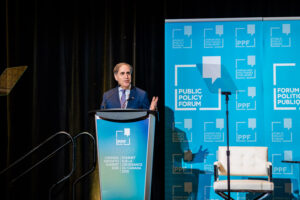
We started the year healthy, but now we have U.S. trade troubles, he says. Canada is a trading nation. So where do we go? He sees a ray of optimism.
Canada’s retaliatory measures would never dissuade the U.S. But the blowback has become more widespread. Europe, Asia, China pushback are adding to the pain in the U.S. “I think that this sort of company that we’re now in with the rest of the world is in fact, our best weapon in getting Donald Trump back to the negotiating table,” he said.
We’ve also learned from Trump’s first term, he said. Confidence in the Canadian economy has never fully recovered from Trump’s early trade threats. Where do we go from here?
Things will look rocky for a while, but we hope tariff threats will ease, he said. Still, we will have our work cut out for us in restoring brisk economic growth. Plan A is getting back to the negotiating table. But what is Plan B, he asks? That will be the focus of conversation today.
Can we do more interprovincial trade? Yes, it’s a worthy effort. (Stay tuned for Doug Ford’s comments later today.) But geography works against us, he said. A CIBC survey of data showed that by taking into account the distances to U.S. markets and their relative size compared to Canadian markets, “you could fully explain why provinces trade more north south than east west.”
The Buy Canada movement is very important, he said. It’s not something Trump can retaliate against. Canadians did it on their own. “It’s a remarkable movement” with no leader — “This is the most grassroots movement ever,” he says. And it will help spur Canadian economic growth.
Capital spending will be important. We’ll need investment to expand industry — pipeline investment, investment in resource extraction. And services are very important, he said. The focus in the U.S. on manufacturing jobs is backwards looking.
Where are there other opportunities? They are in the knowledge economy, and we need to talk about whether Canada is attracting the right talent or cultivating the right talent in areas like AI. If you look at Canada’s natural resources, you tend to look at the trees and rocks and so on, but one of our natural resources is our people. We are a talent magnet. We can put that intellectual capital to work. We have a lot of opportunities that we haven’t fully tapped in the knowledge economy where we can get some economic growth.
There’s a risk that we don’t get this trade deal. And if they did go ahead with the tariffs they announced on April 2, or if the tariffs against Canada remain, we will have a recession here in Canada. To get us out of that recession, we will need some thinking about the longer-term things we can do to make us less vulnerable to the next U.S. President who makes the wrong decisions.
Hope for the best in trade negotiations, but it’s time to put on our thinking caps, he concluded.
9:00 a.m.
Policy change ‘at the velocity of a social media post’
CPAC host and anchor Michael Serapio is this year’s Growth Summit emcee — his third time in the role.
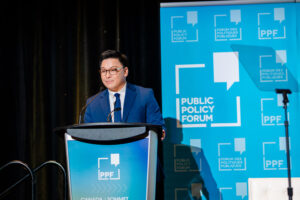
“And boy, to say that the world has changed in the last three months would be an understatement,” he says.
“In the last three and half months alone, the winds of change blowing into this country from our neighbours below have cost Canada not only jobs and investment but also changed our assumptions about Canadian trade and how — and with whom — we build our future prosperity.”
But the challenges aren’t all with the U.S., he notes. Chaos south of the border only adds urgency to longstanding problems here including productivity and competitiveness, which will be discussed in detail throughout the day.
PPF President and CEO Inez Jabalpurwala takes the stage for the welcome address.
“As we have been building our agenda these last months, we have been mindful of a heightened sense of urgency. Crafting an agenda with lasting resonance has been particularly challenging in a year when the global policy agenda changes at the velocity of a social media post,” she says.
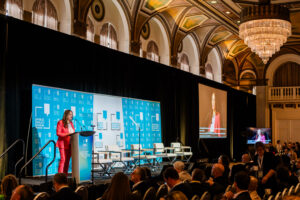
Jabalpurwala announces the launch of PPF’s latest project — Mission Canada, a blueprint to leverage Canada’s economic advantage. “This ambitious project will find ways to dismantle internal impediments to productivity and competitiveness, accelerate development in energy, critical minerals, infrastructure and other key producing sectors, as well as diversify Canadian trade,” she says.
She also thanks the event’s sponsors as well as the sponsors of the expert pre-summit dinners, which were held at various locations across the city on Wednesday night. “Groups were huddled around tables discussing everything from local journalism to Arctic security, housing to life sciences, the energy transition to the Canada-U.S. relationship,” she says. (Check out coverage from our media partner POLITICO.)
“I hope you enjoy this ‘extraordinary event in extraordinary times’ — what one of our board members called an intellectual spa! And while we can’t promise a eucalyptus steam room I do know you’ll leave inspired, invigorated and equipped with new ideas and enthusiasm to go make more and better policy,” she concludes.
8:52 a.m.
JP Gladu is back to introduce P.J. Akeeagok, Premier of Nunavut, for closing remarks.
“The conversation in this country has changed and it needs to take hold,” he says.
“There is great leadership being shown in uncertain times,” says Premier Akeeagok. “When Indigenous people are at the table, projects and certainty, you get that. The projects we’re talking about move much faster.”
At the heart of the conversation is how to grow the Canadian economy, especially at a time when Canada’s economy is facing unprecedented challenges. “The shift in the geopolitical landscape really radically altered just in the last few months, both the national and international and circumpolar world really has put a spotlight to the north,” he said.
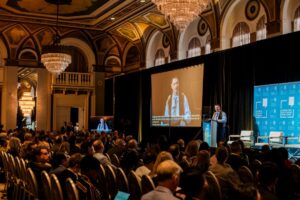
“All eyes right now are on the Arctic,” he says. “We are the gateway to the Northwest passage and at the forefront of the conversation when we’re talking about security and sovereignty.”
We are at a moment where we all have to rise up. The North offers so much in terms of certainty, opportunity, and I think we are on the cusp of some great things as acountry that are really nation-building.
There is unity in Nunavut to build Arctic security and a vision for the North, he says. Part of this includes nation-building projects. There are key projects coming that allow Inuit to be at the centre of the development, he says.
For instance, he says he just signed a Memorandum of Understanding with Manitoba Premier Wab Kinew to advance a fibre link between southern Canada and the North — the first of its kind.
HEAR MORE: Mark Podlasly and JP Gladu have both been guests on PPF’s podcast WONK. Listen to their episodes here and here.
8:40 a.m.
“It’s become very apparent that the Indigenous economy is one that is quite extraordinary, and one that we need to really pay attention to,” says JP Gladu, in opening remarks.
Over the next decade, Canada anticipates $30 billion in capital investments in major energy mining and forest projects, he notes. “These, my friends, are nation building projects that rely on skilled trades and increasingly on the strong relationships and partnerships with Indigenous people.”
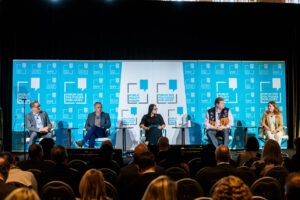
In 2022 the Indigenous economy was at just over $60 billion, which grew from 10 percent the year before. “When Indigenous people are at the table, projects move faster,” he says.
Mark Podlasly, CEO of the First Nations Major Projects Coalition, is moderating the panel. He starts with a question around investment challenges and the benefits of Indigenous equity. What’s the main barrier to Indigenous participation in major projects?
Sajid points out that the Indian Act means Indigenous people have not been able to use their land as collateral for loans. The federal Indigenous Loan Guarantee program implemented last year means this lending is seen as lower risk and organizations are able to get better returns.
Indigenous communities need a loan guarantee because they can’t use their land as collateral. The Loan Guarantee Program was created to fill that gap — the government backs the loan so it’s seen as lower risk and better terms can be offered.
Hungerford reminds the panel that First Nations frequently do not have the ability to leverage reserve lands, which raises challenges because there’s no access to capital markets.
When you think about Arctic projects, there are few lenders who can take big risks, which is where the Canada Infrastructure Bank steps in, explains Hillary Thatcher. It uses accelerator funding, debt provision and direct equity lending to ensure communities have the capital to have a seat at the table.
Sajid speaks about the success of the Alberta Indigenous Opportunities Corporation program, which came out of Truth and Reconciliation Commission’s calls for equity Indigenous access to capital. Sajid says the program started at $1 billion, focusing mainly on natural resource projects, but since then their mandate has expanded to $3 billion and more areas, from telecommunications to tourism.
“In the last five years … we’ve impacted 43 unique Indigenous and Metis communities,” she says, including a community that was able to build a multiplex after a wildfire. Ultimately, the program will generate billions in impact, Sajid adds.
Podlasly asks if Federal Loan Guarantees will work with territorial and provincial projects going forward. Michael Bonshor, with the Canada Indigenous Loan Guarantee Corporation, says the plan moving forward is to collaborate with Alberta, Ontario and soon, B.C. to meet the scale of anticipated investment. “We have $10 billion at our disposal. We’re going to need more.” The more efficient we can be collaborating with provinces, the better, he says.
Podlasly asks Hungerford about working to get access to capital for communities across Canada. Hungerford mentions that, when looking to how economies grow and what institutions they need to grow the Indigenous economy, he considered the province of Quebec, and how it was able to transform itself in the mid-century through major projects like Hydro Quebec, asset management that was able to invest in the economy, venture capital, and other institutions.
With loan guarantees, he says, we have some of that in place. But, he asks, can you imagine if we had something like the tools of the World Bank — concessionary financing, other kinds of business-focused finance — available for Indigenous communities. In the future, he says, we will see some programs starting to evolve, so it’s not the project itself, it’s ownership of the spin-offs — construction, trades, and so forth that are associated with the project.
What kinds of projects is CIB investing in, Podlasly asks Hillary Thatcher. She cites B.C.’s ‘Call to Power’ green electricity projects, where CIB worked closely with various groups. They were able to bring in more private capital and reduce cost for rate players. “We’re trying to help Canada through its green transition.” Small modular reactors will be a game changer, both for energy and for Indigenous partnership, she adds.
A question from the floor about the role of polytechnics in Indigenous economic growth. Hungerford notes that engineering is an area where we will need to see a lot more Indigenous people. But, beyond that, there is a need for governance of these development corporations. “How can we get directors trained up so they are able to run these enterprises?”
“When Nations participate in these deals they are building their financial acumen,” Sajid adds, “But these are really complex projects.”
Looking forward, Sajid says the Alberta Indigenous Opportunities Corporation is “just getting started.” She says that 10 years ago, this would have been a completely different conversation, but recent developments in provincial and federal loan programs means it’s “a really exciting place to be.” Canada is at a pivotal moment when we’re having conversations about food and energy security, Sajid says, and it’s important that Indigenous participation remains at the core of those conversations moving forward.
Michael Bonshor concludes by noting that the gap in income between those living on reserve and off have been persistent. It’s going to be programs like Indigenous loans guarantees that are going to help address that. In 10 or 20 years, those gaps will be gone, he says. Hungerford mentions the tension that exists between Indigenous communities who want to develop real estate and municipalities that often put up roadblocks to that development — an area that policy may be able to help resolve.
7:30 a.m.
We kick things off with the third annual Indigenous Ownership and Inclusive Growth Breakfast, focusing on Indigenous leadership in Canada’s next big energy, infrastructure and mining projects. JP Gladu, Principal at Mokwateh, is the co-host of the session.
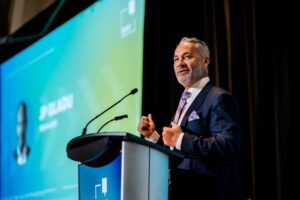
We’ll be hearing this morning from panelists:
- Hillary Thatcher, Managing Director, Investments, Canada Infrastructure Bank
- Geordie Hungerford, Indigenous Finance Executive
- Shafak Sajid, Interim Director, Engagement Alberta Indigenous Opportunities Corporation
- Michael Bonshor, Board Chair of Canada Indigenous Loan Guarantee Corporation
7:30 a.m.
Watch #GrowthSummit2025 live on CPAC.
Thursday, 7:00 a.m.
Growth Summit 2025 starts now. PPF Media will be reporting live throughout the day from the Fairmont Royal York Hotel in Toronto. We’ll have highlights from all the speakers as they delve into the most pressing issues facing Canada’s economy in what has been an extraordinary year of change and challenges.
Among the panelists and speakers we’ll be hearing from at this year’s sold out event: former chief trade negotiator for Canada Steve Verheul, Premier Doug Ford, Canadian diplomat Louise Blais, Globe and Mail columnist Andrew Coyne and many more. See the full roster of speakers here.
Here’s a taste of what’s in store. Watch our highlights from 2024.


